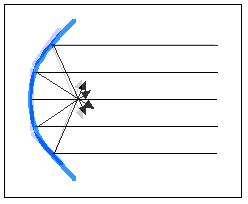 We
have already established that the Law of Reflection (angle of
reflection = angle of incidence) applies to plane mirrors. If you
would place several plane mirrors into a beam of light that contained
parallel rays, you would find it relatively easy to arrange the flat
mirrors so that they would reflect their portion of the beam through
a common spot. (See the diagram at left.) If you were mathematically
inclined, you would notice that you had arranged the mirrors to
approximate a curve called a parabola. (If you were mathematically
inclined, it would be an interesting exercise to prove that this
curve is a parabola...)
We
have already established that the Law of Reflection (angle of
reflection = angle of incidence) applies to plane mirrors. If you
would place several plane mirrors into a beam of light that contained
parallel rays, you would find it relatively easy to arrange the flat
mirrors so that they would reflect their portion of the beam through
a common spot. (See the diagram at left.) If you were mathematically
inclined, you would notice that you had arranged the mirrors to
approximate a curve called a parabola. (If you were mathematically
inclined, it would be an interesting exercise to prove that this
curve is a parabola...)
As the number of plane mirrors increases in this array, the mirrors approximate the parabola more and more closely, and the beam focuses into a smaller and smaller area. For a perfectly-smooth parabolic mirror, the beam will be reflected through a single point, called the focus of the mirror.